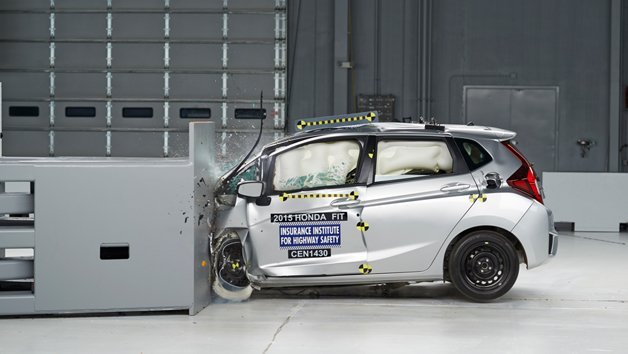Honda Fixes Fit Flaw, Improves Performance on Key Crash Test

They thought they had reinforced a steel bumper beam that runs behind the front fascia of the vehicle. But it had broke free in the impact, and the result was much more of the crash energy being absorbed on the driver's side of the car.
So Honda did something unusual. Even as this new-generation Fit started arriving in showrooms, the engineers raced to redesign the front of the car, and then asked IIHS to re-test the vehicle.
The result: The Fit's grade on the small-front overlap test improved from "marginal" on the earlier test to "acceptable," a result that IIHS announced Thursday morning. Because the Fit had already received 'good' marks on the organization's four other crash tests, the Fit will now earn the 'Top Safety Pick' overall title, the IIHS' second-highest ranking.
Many automakers, including Honda, often use such rankings in their advertising campaigns, and it's an especially important differentiator in this case, because most of the subcompact cars that fall into the IIHS' "minicar" category typically fare poorly on the small-front overlap test. A marginal score would have prevented them from claiming that title.
"We had targeted 'Top Safety Pick,' and just weren't satisfied with not achieving that," said Chuck Thomas, Honda's chief engineer for vehicle safety, said Wednesday. "We had studied the results of that test, and made some modifications to the front bumper."
Especially in smaller cars, automakers try to direct crash forces toward the far sides of the cars. In the initial Fit crash test, the steel bumper beam responsible for directing that energy to the far side of the crash failed. Honda reconfigured the welds on the bumper beam, and those changes led to the improved result.
"It's a very demanding test that puts unusual demands on vehicle structure," Thomas said. "Crash tests, by their nature, are very dynamic, and there's some variability. We try to account for that, but the welding that we had on there wasn't able to make that connection."
Introduced a little more than two years ago, the small-front overlap test has quickly become the most difficult for automakers to master. Researchers simulate a crash in which the front quarter of a car crashes into a stationary object, like a parked car or tree, at 40 miles per hour.
It's more stringent than the tests monitored by the National Highway Traffic Safety Administration, and a difficult one for cars to handle, because the crash forces can bypass safety structures and penetrate the cabin. IIHS says that 25 percent of serious injuries sustained in traffic accidents come from this kind of accident.
Honda said it made the welding changes on its production line starting on June 9. Though there is no regulatory requirement, the company said it will let the approximate 12,000 owners who had already bought the new '15 Fit this year bring back their cars for a free upgrade to the stronger bumper. Owners will receive notices in the mail in late September, a Honda spokesperson said.
It's not unusual for automakers to ask for an extension or a re-test on a particular model, says Russ Rader, a spokesperson for the IIHS. What is more unusual is Honda offering the product update on vehicles already sold.
"We commend Honda for its quick response to the test, and for taking the additional step of replacing the bumper beams on early-production vehicles," said IIHS president Adrian Lund. "People who bought cars produced earlier in the year should take advantage of this free replacement to improve protection in small-front overlap crashes."
With the update, Honda now has nine vehicles that have received "Top Safety Pick" status or higher across its mainstream and Acura brand lineups. In the minicar segment, only the Chevy Spark also claimed "Top Safety Pick" status. The Spark also earned an 'acceptable' mark on the small-front overlap test, and 'good' ratings on the other four tests.
Related News


